Opisthoteuthis massyae
Roger Villanueva, Michael Vecchione, and Richard E. YoungIntroduction
O. massyae is known only from the Eastern Atlanic. It is unusual in having especially thick arms I in mature males.
Characteristics
- Arms and web
 Click on an image to view larger version & data in a new window
Click on an image to view larger version & data in a new window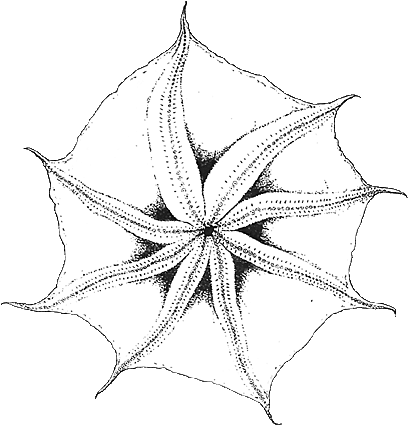
Figure. Oral view of O. massyae, mature male, 75 mm ML. Drawing from Villanueva et al., 2002.
- Arms subequal in length.
- Arms I in males very thick, muscular and robust proximally to level of web margin; arms I normal in females.
- Arm sucker counts 82-106 (males) or 85-87 (females).
- Web sectors approximately equal.
- Males with two fields of enlarged suckers present; largest sucker diameter of distal field less than that of proximal field.
- Proximal field with typically 7-8 suckers enlarged and occupying positions between suckers 2 and 13; sucker 7 usually largest; all arms with equal enlargement.
- Distal field with usually 9-11 suckers enlarged, typically beginning with sucker numbers 34-40; suckers 40-41 usually largest; distal enlargement absent on arms I, moderate on arms II and maximal on arms III and IV.
- Cirri short; longest 2.0-6.4 mm or 7.8% of ML in mature males.
- First cirri appear between suckers 3 and 5.
- Web nodules
- Multiple web nodules (= web supports) present on ventral margin of each arm; proximal support stout, subsequent ones weak; supports number 7-20 per arm (ave. 14); supports typically begin at level of sucker 35-37, approximately the first distal enlarged sucker in males.
Comments
More details of the description of O. massyae can be found here.
O. massyae differs from all members of the genus (where males are known) in having especially broad arms I in mature males. Also unusual are enlarged suckers in the distal field on arms II-III, a feature that it shares only with O. pluto.

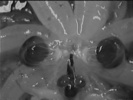
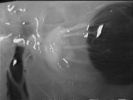
Figure. Aboral view of mature male O.massyae, fresh specimen dissected on board after collection on the SE Atlantic. On the left image, note the marked increased thickness of arm I characteristic of males of this species, the well developed eyeballs and the central nervous and digestive systems. Rigth, note the optic nerve, the white body and the four boundles of nerves on the eyeball. ©
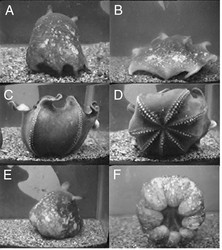
Opisthoteuthis massyae. © Journal of the Marine Biological Association of the United Kingdom
Figure. Photographs from videorecordings of O. massyae in a shipboard aquarium on the SE Atlantic showing different behaviours after capture. A, Bottom-resting (female, 250 g total weight, TW); B, Flat-spreading (male 450 g TW); Web-inversion in lateral (C) and oral (D) views (male 550 g TW); Ballooning response in lateral (E) and oral (F) views (male 450 g TW). White spots on the surface of the specimens are due to skin damage caused by capture. From Villanueva (2000) (reported in this paper as O.grimaldii)
Nomenclature
This species was originally described as Cirroteuthis umbellata by Massy in 1909. Grimpe (1920) recognized that it was a new species and named it Cirroteuthopsis massyae. Villanueva et al. (2002) placed it in the genus Opisthoteuthis. Opisthoteuthis vossi Sanchez and Guerra, 1991, is a junior synonym of O. massyae (Villanueva et al., 2002).
Life History
Males reach a larger size than females; males weigh up to 5750 g and females up to 2959 g (Boyle, et al., 1998). The relationship between total weight and total length is TW = 19x10-5xTL2.7 for both sexes (Villanueva and Guerra, 1991).
Mature eggs are 10-12 mm long, 4.8-5.0 mm wide. An interesting feature recorded in the ovary of O. massyae is the formation of a follicular sheath around each maturing egg that remains attached to the ovary after mature eggs are released into the proximal oviduct (Daly et al. 1998, Boyle & Daly 2000). The number of empty follicular sheaths increases linearly with body size and represents an estimation of the egg-laying record over the female’s lifetime. The number of eggs in the ovary and oviducts plus the number of empty follicular sheaths, provides an accurate estimation of the absolute fecundity and for Opisthoteuthis massyae was 1396 eggs (mean), with an individual maximum of 3202 eggs (Boyle & Daly 2000).
Distribution
Type locality: Off Ireland at 50°31'N, 11°31'W, 1226-1450 m. O. massyae is known only from the Eastern Atlantic from off Ireland to off Namibia and possibly South Africa (Villanueva et al., 2002). Abundance estimations of O. massyae are of 1.5-5.7 ind km-2 at 750-150 m depth in the NE Atlantic (Collins et al 2001) and 202-499 ind km-2 at 829-836 m depth in the SE Atlantic (Villanueva and Guerra 1991).
References
Boyle, P.R. & Daly, H.I. 2000. Fecundity and spawning in a deep-water cirromorph octopus. Marine Biology 137, 317-324.
Collins, M.A., Yau, C., Allcock, A.L. & Thurston, M.H. 2001. Distribution of deep water benthic and bentho-pelagic cephalopods from the NE Atlantic. Journal of the Marine Biological Association of the United Kingdom 81, 105-117.
Daly, H.I., Boyle, P.R. & Collins, M.A. 1998. Reproductive status of Opisthoteuthis sp. over an annual cycle. South African Journal of Marine Science 20, 187-192.
Massay, A. L. (1909). The Cephalopoda Dibranchiata of the coasts of Ireland. Fisheries, Ireland, Scientific Investigations for 1907, 1: 1-39.
Grimpe, G. 1920. Teuthologische Mitteilungen V. Zwei neue Cirraten-Arten. Zoologischer Anzeiger, 51: 230-243.
Sanchez, P. and A. Guerra. 1989. A new species of cirrate octopod Opisthoteuthis vossi from the southeast Atlantic (Cephalopoda: Octopoda). Bull. Mar. Sci., 44: 1159-165.
Villanueva, R. and A. Guerra. 1991. Food and prey detection in two deep-sea cephalopods: Opisthoteuthis agassizii and O. vossi (Octopoda: Cirrata). Bulletin of Marine Science, 49: 288-299.
Villanueva, R. 1992. Continuous spawning in the cirrate octopods Opisthoteuthis agassizii and O.vossi: features of sexual maturation defining a reproductive strategy in cephalopods. Marine Biology, 114: 265-275.
Villanueva, R. 2000. Observations on the behaviour of the cirrate octopod Opisthoteuthis grimaldii (Cephalopoda). Journal of the Marine Biological Association of the United Kingdom, 80: 555-556.
Villanueva, R., Collins, M., Sanchez, P. and N. Voss. 2002. Systematics, distribution and biology of the cirrate octopods of the genus Opisthoteuthis (Mollusca, Cephalopoda) in the Atlantic Ocean, with description of two new species. Bulletin of Marine Science 71(2):933-985.
Title Illustrations

| Scientific Name | Opisthoteuthis massyae |
|---|---|
| Comments | holotype of Opisthoteuthis "vossi" |
| Reference | Sanchez, P. and A. Guerra. 1989. A new species of cirrate octopod Opisthoteuthis vossi from the southeast Atlantic (Cephalopoda: Octopoda). Bull. Mar. Sci., 44: 1159-165. |
| Sex | Male |
| Size | 55 mm ML |
| Type | Holotype |
| Copyright | © 1989 Bulletin of Marine Science |
| Scientific Name | Opisthotetuhis massyae |
|---|---|
| Reference | Villanueva, R., Collins, M., Sanchez, P. and N. Voss. 2002. Systematics, distribution and biology of the cirrate octopods of the genus Opisthoteuthis (Mollusca, Cephalopoda) in the Atlantic Ocean, with description of two new species. Bulletin of Marine Science 71(2):933-985. |
| Sex | Male |
| Life Cycle Stage | Mature |
| View | Ventral and dorsal |
| Size | 75 mm ML |
| Copyright | © 2002 Bulletin of Marine Science |
About This Page

Instituto de Ciencias del Mar (CSIC), Barcelona, Spain

National Museum of Natural History, Washington, D. C. , USA

University of Hawaii, Honolulu, HI, USA
Page copyright © 2016 , , and
All Rights Reserved.
- First online 13 May 2003
- Content changed 22 July 2006
Citing this page:
Villanueva, Roger, Michael Vecchione, and Richard E. Young. 2006. Opisthoteuthis massyae . Version 22 July 2006 (under construction). http://tolweb.org/Opisthoteuthis_massyae/20161/2006.07.22 in The Tree of Life Web Project, http://tolweb.org/





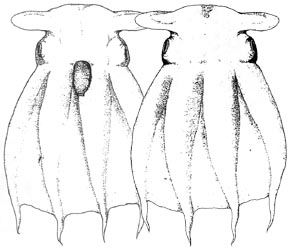
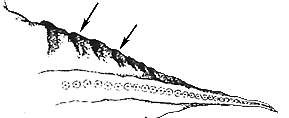




 Go to quick links
Go to quick search
Go to navigation for this section of the ToL site
Go to detailed links for the ToL site
Go to quick links
Go to quick search
Go to navigation for this section of the ToL site
Go to detailed links for the ToL site